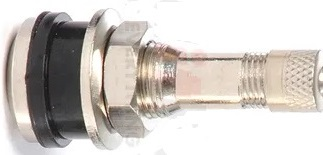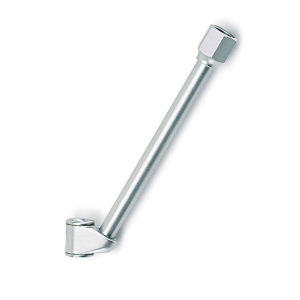Valve stem extensions come in two "flavors". One being a longer metal stem the other is some sort of "extender" that screws onto the end of a standard stem.
If you chose the long metal stem route, you probably should have them installed by a tire shop that services Heavy trucks as they have the experience and should know how to install properly. The stem for the inner tire can be straight or almost straight but needs to be long enough to come through the outer wheel "hand hole". The long stem may look like this one.
The outer stem can be a regular brass stem like this one.

it will help if you have a "dual foot" inflator tool. Like this.
 If you have short metal stems as shown above and a "Dual-Foot" inflation adapter you should be able to get to both the inner and outer short stems. One end you Push on the inner tire. The other end you Pull onto the valve for the outer tire.
If you have short metal stems as shown above and a "Dual-Foot" inflation adapter you should be able to get to both the inner and outer short stems. One end you Push on the inner tire. The other end you Pull onto the valve for the outer tire.
The above doesn't answer the question for those that use TPMS or want easy access to allow measurement of tire pressure. You can use the "other flavor of extender", a flexible "Hose" extenders BUT you REALLY need to pay attention to the following:
1. Be sure to tighten the hose properly. That means no leaks (test with some soapy water) and not over-tighten. I screw the hose on till the air stops leaking then tighten about 3/4 to 1 additional turn. I then check and confirm no air leak.
2. The outer end needs to be SOLIDLY attached. I use pop-rivets and the small 'L" bracket that comes with the Wheel Master stainless steel hose kit (#8001 or #8005 depending on wheel diameter). Like this. (shown with TPMS sensor)

3. When adding air you should hold the hose so you are not loosening the attachment point as pushing an air chuck or pressure gauge on an extender can generate a lot of force which can bend or loosen the attachment.
4. Do Not over-tighten the hose extenders. There are small rubber "O" ring gasket seals that can be torn resulting in a slow leak.
5 As with all rubber parts, I had one of my hose seals failed after 9 years. The rubber is any seal can eventually fail due to "old-age". This applies to hoses, rubber valve stems and any other rubber part in your car, truck or RV. One advantage of my using a TPMS I was able to see the slow ( 2 - 3 psi per hour) and after a close inspection of the hose extender confirmed.
Some people have used a stiff extender instead of the flexible hose. The downside of these extenders is that it is hard to "attach" the outer end to stabilize the extender. This might allow the extender to vibrate or unscrew which can develop into a leak. I think that these "extenders" potential to leak is what has led to the negative opinions of extenders..
##RVT1033



No comments:
Post a Comment
Thanks for your comment. We look at each one before posting to keep away the spammers.